Distinguishing Roaches from Waterbugs: A Detailed Guide
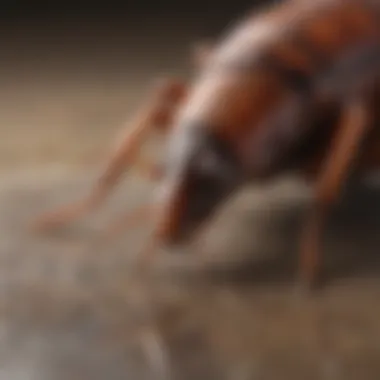
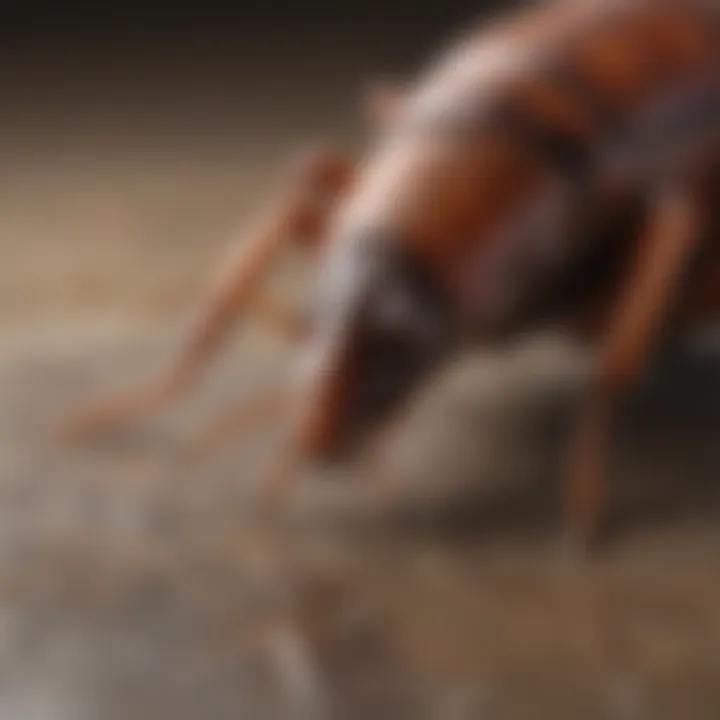
Intro
The confusion between roaches and waterbugs is common. This misunderstanding is often due to their similar appearances and habitats. However, a closer look reveals significant differences in their biology, behavior, and ecological roles. Understanding these distinctions is vital for effective pest management and home care. This guide explores these differences, aiming to equip homeowners and design enthusiasts with the knowledge necessary to address potential infestations properly.
It's important to note, roaches are primarily terrestrial insects, while waterbugs, despite their name, are mostly aquatic. This distinction holds when considering pest control measures and habitat management strategies. Moreover, knowing these differences can aid in making informed decisions regarding home and garden care.
Understanding the Differences
Roaches, formally known as Blattodea, are a group of insects that typically dwell in dark, damp areas. Common types include the German cockroach and the American cockroach. They have a flat body and long antennae. In contrast, waterbugs belong to the order Hemiptera, particularly the family Belostomatidae. These insects have a more robust body and often appear larger than most roaches.
Biology
The anatomy of roaches is characterized by their two pairs of wings and long, slender legs. They produce an unpleasant odor when disturbed, which is an evolutionary adaptation. Waterbugs, on the other hand, possess a unique body structure designed for swimming. They have a wider build and paddle-like legs suited for aquatic environments.
Habitat
Roaches are often found in human dwellings. They prefer warm, moist areas, which makes kitchens and bathrooms ideal. Waterbugs typically inhabit freshwater environments, such as ponds and streams. Their presence indicates a healthy aquatic ecosystem. While roaches scavenge for food, waterbugs are predatory, feeding on smaller aquatic creatures.
Design Inspiration
Understanding pest characteristics can prevent infestations. If a homeowner designs their outdoor space with suitable materials and plants, it can deter pests. This section explores effective strategies for designing pest-resistant spaces.
Landscaping for Pest Management
By selecting proper landscaping choices, homeowners can discourage both roaches and waterbugs. These choices include:
- Using native plants: Native plants are more resilient to local pests.
- Creating physical barriers: Paths with gravel discourage nesting.
- Pruning shrubs: Keeping plants trimmed reduces shelter for roaches.
Color Choices
Interestingly, while color does not directly affect pest behavior, some shades can influence design choices in the garden to encourage natural repellency. Lighter colors might deter some insects, while darker tones could attract them. Choosing plant colors can complement designed spaces while remaining mindful of pest management.
Practical Tips
Maintaining a pest-free environment requires regular upkeep and planning. Here are some practical tips to help achieve this goal.
Maintenance & Care
- Regular Cleaning: Keep areas free from food debris.
- Seal Cracks: Ensure all entry points are sealed to deter roaches.
- Monitor Water Sources: Remove standing water to limit waterbug habitats.
Budgeting & Planning
Effective pest management might require an upfront investment. Prioritizing spending on preventive measures can save costs on future infestations. Always consider professional pest control if infestations persist.
"Preventive measures reduce long-term costs compared to reactive treatments."
Intro to Roaches and Waterbugs
Understanding the distinctions between roaches and waterbugs is critical for both homeowners and those invested in interior design or gardening. These insects are often confused due to their similar appearances and the overlapping environments they inhabit. However, their differences play a significant role in pest management and ecological impact.
This section aims to clarify the importance of recognizing these differences. Knowing whether you are dealing with a cockroach or a waterbug can lead to more effective management strategies. For example, roaches thrive indoors, often making them a nuisance in kitchens and bathrooms. In contrast, waterbugs tend to occupy outdoor habitats such as ponds and marshes.
By highlighting the characteristics, behaviors, and needs of each insect, homeowners can adopt more focused approaches to pest control. This awareness is not just preventive; it can also protect the environment and maintain the structure of homes. Therefore, a deep dive into the terms and definitions related to these insects is indispensable for effective pest management and overall awareness of household ecology.
Understanding the Terms
To properly distinguish between roaches and waterbugs, one must first grasp the definitions and general perceptions associated with these terms.
- Roaches: Generally, when people refer to roaches, they mean members of the order Blattodea. These insects are known for their resilience and adaptability, frequently found in human dwellings. Common types include the German cockroach and the American cockroach.
- Waterbugs: This term typically applies to members of the family Belostomatidae. The name can also refer to other aquatic insects, but the predominant species here are known for their size and predatory nature. They are often found in freshwater habitats.
Each name conjures different images and meanings, leading to common misconceptions. Roaches often evoke fear and disgust, commonly viewed as pests. On the other hand, waterbugs may be perceived as merely benign river dwellers. Understanding these terms sets the foundation for further exploration into their biology and ecological roles.
Taxonomy and Classification
Understanding the taxonomy and classification of roaches and waterbugs is essential in differentiating between the two groups. This section provides insight into the unique characteristics and classifications that set them apart from each other. Taxonomy offers a systematic way of categorizing organisms, which aids in the study of their behavior, ecology, and biology. By knowing where each species fits within the broader classification, readers can gain a deeper appreciation for their individual roles within ecosystems.
Roaches: Scientific Overview
Roaches, commonly known as cockroaches, belong to the order Blattodea. This order includes a variety of species, with approximately 4,500 known types. The most recognized species include the American cockroach, German cockroach, and the Oriental cockroach. Their classification can be broken down into three key families: Blattidae, Blaberidae, and Nocticolidae.
Roaches are primarily characterized by their flat, oval bodies and long antennae. Adult roaches generally possess two pairs of wings, although not all species are proficient fliers. They have a unique reproductive system; females produce egg cases containing multiple eggs, which hatch into nymphs. These nymphs resemble adults but lack fully developed wings.
Within ecosystems, roaches play a dual role. On one hand, they are essential decomposers, aiding in the breakdown of organic matter. On the other hand, they can be pests, often infesting human dwellings, leading to health concerns. Understanding their scientific background helps inform effective pest control methods and habitats they prefer.
Waterbugs: Scientific Overview
Waterbugs, classified under the order Hemiptera, are also known as true bugs. Within this order, the family Belostomatidae is most notable, including species like the toe-biters and the giant water bugs. Waterbugs typically have a more elongated body structure compared to roaches, adorned with long, slender legs adapted for swimming.
These insects are aquatic and can be found in freshwater habitats like ponds, lakes, and marshes. Their life cycle includes distinct stages: eggs, nymphs, and adults. Female waterbugs lay eggs on floating vegetation, and once hatched, nymphs resemble tiny adults, gradually maturing into larger forms.
Waterbugs are predatory, feeding on fish and amphibians. Their ecological niche emphasizes their role as both predators and prey in aquatic systems, impacting local food webs. Their classification not only highlights their biological traits but also helps in understanding their interactions with other species in the same habitat.
Key Takeaway: Understanding the taxonomy of roaches and waterbugs is critical in discerning their distinct behaviors and ecological roles, providing valuable insights for homeowners and gardeners alike.
Physical Characteristics
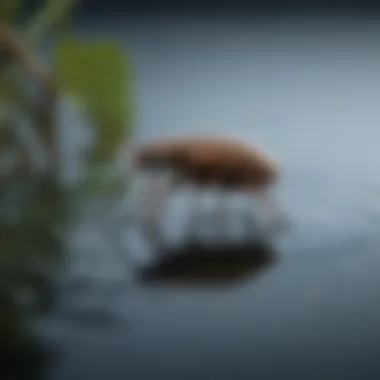
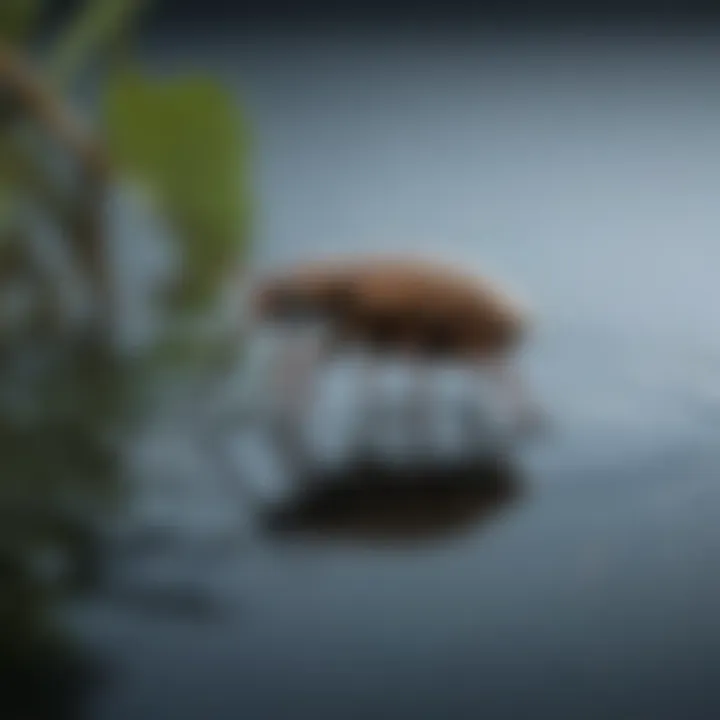
In the domain of pest identification, physical characteristics serve as a cornerstone for distinguishing between roaches and waterbugs. Homeowners and enthusiasts alike benefit from understanding these traits, as they can greatly aid in effective pest management. Specific elements such as size, coloration, and body structure play critical roles in identification. Additionally, recognizing these features can lead to more informed decisions regarding pest control strategies.
Anatomical Features of Roaches
Roaches are generally characterized by their flattened bodies and long antennae, which can span several inches. The size of roaches varies between species, but most are typically 1 to 4 inches long. Common varieties like the American cockroach have a reddish-brown color, while others may appear darker. The wings of adult roaches can sometimes be used for gliding rather than sustained flight, although some species are entirely wingless.
In addition to their signature features, roaches have a distinct set of legs that promote quick movement. They are equipped with six legs, allowing them to scurry away quickly when threatened. This speed and agility are often vital for their survival in hostile environments.
Anatomical Features of Waterbugs
Waterbugs, on the other hand, exhibit a different anatomical structure compared to roaches. Adult waterbugs tend to be larger, usually measuring about 1.5 to 4 inches in length. They possess a more robust body and a unique flattened appearance conducive to their aquatic lifestyle. The coloration is predominantly dark brown to black, which aids in camouflage within their natural environments.
Another notable aspect is their long legs, which are adapted for swimming. Waterbugs have two pairs of legs where the hind pair are much longer than the front ones. This feature allows them to navigate efficiently through water. Furthermore, they have distinctive mouthparts developed for feeding, as they typically hunt other insects and small aquatic animals.
Understanding these anatomical features is essential for anyone aiming to differentiate between these two pests.
In summary, the physical characteristics of roaches and waterbugs not only distinguish them but also highlight their adaptations to different environments. By focusing on these details, homeowners can make informed choices about pest management and control.
Habitat and Distribution
Understanding the habitat and distribution of roaches and waterbugs is essential for identifying where these insects thrive and how they interact with their environments. Each species has its unique preferences that influence their biological behavior, life cycle, and even their encounter with humans. By recognizing where these creatures are commonly found, homeowners and enthusiasts can better devise strategies for managing their presence.
Moreover, knowledge about their habitats can inform individuals about the conditions that favor the growth of these pests and help foresee any potential invasions. For example, understanding that roaches prefer warm, dark areas can compel residents to maintain cleaner, well-lit spaces that discourage infestation. Similarly, awareness of waterbugs living near water sources can prompt homeowners to address any stagnant water near their surroundings, preventing their attraction.
Typical Habitats for Roaches
Roaches are notorious for their adaptability and can thrive in a variety of habitats. They are commonly found in:
- Urban Areas: Apartments, restaurants, or any structures with abundant food and moisture.
- Household Locations: Kitchens, bathrooms, and basements, where warmth and darkness prevail.
- Outdoor Environments: Mulch piles, compost heaps, and areas around garbage are also favorable.
Their preference for dark environments usually means that during the day, they seek refuge in crevices, cracks, and other sheltered locations. This tendency to hide away from light makes them particularly difficult to control, as they can easily invade spaces without detection.
Typical Habitats for Waterbugs
Waterbugs, particularly the large species such as the Belostomatidae, prefer habitats closely associated with water. They are typically found in:
- Freshwater Bodies: Ponds, lakes, swamps, and marshes, where they can hunt for food.
- Wetlands: These areas are ideal for breeding and sustaining their life cycle.
- Stagnant Water Sources: Areas with low water flow, which provide shelter and abundant food source.
Unlike roaches, their habitat is primarily aquatic or semi-aquatic. They are often found under vegetation or debris in the water, making them less likely to invade indoor spaces. However, their propensity to search for food can occasionally lead them into homes, especially during warmer months.
"Recognizing the typical habitats of roaches and waterbugs can empower homeowners with knowledge essential for effective pest management."
In summary, understanding the distinct habitats of these insects enhances awareness about their behavior and informs preventative measures that can be implemented. By taking action based on this knowledge, homeowners can effectively mitigate infestations and reduce their ecological impact.
Behavioral Patterns
Understanding behavioral patterns is critical when distinguishing between roaches and waterbugs. These insects display distinct behavior that can inform pest management strategies. Observing their movement, feeding habits, and social interactions can provide insights into their environmental roles and the measures necessary to control their populations. By understanding how each species behaves, homeowners can apply effective techniques for prevention and management, reducing infestation risks.
Roach Behavior and Movement
Roaches are primarily nocturnal, emerging under the cover of darkness. They are quick, agile creatures that can scurry away rapidly from perceived threats. This makes them difficult to spot during the day. Roaches prefer warm, humid environments, often hiding in cracks, crevices, and dark areas like kitchens and basements. They are social insects, often found in groups, which can lead to rapid population growth.
Foods are a priority for roaches. They are omnivorous scavengers, consuming a wide variety of organic materials. Their flexibility in diet means that they often thrive in human environments, where food waste is abundant.
Common behaviors include:
- Grooming: Roaches spend a significant amount of time cleaning themselves to remove debris and parasites.
- Communication: They use pheromones to signal food sources and warn others about danger.
Understanding these behaviors can help in setting traps or using bait effectively. For instance, placing baits near common hiding spots can lead to efficient roach control.
Waterbug Behavior and Movement
Waterbugs, unlike roaches, are primarily aquatic. They thrive in freshwater habitats like ponds and streams. Their movement is often characterized by swift swimming, using their legs to propel themselves through water. This agility underwater sets them apart from the terrestrial lifestyle of roaches.
Waterbugs are predators, feeding mainly on smaller aquatic creatures. They have a unique feeding behavior. They use specialized mouthparts to inject venom into their prey, which helps in immobilizing them.
Key behavioral traits include:
- Hunting Strategy: Waterbugs hunt by ambushing their prey. They remain still and then strike quickly.
- Surface Breathing: They come to the surface to breathe, surfacing frequently when not actively hunting.
Understanding waterbug behavior aids in identifying them and distinguishing them from roaches, especially in shared environments near water sources. Knowing their preferred habitats can help in managing their presence around homes and gardens.
The distinction in behavior between roaches and waterbugs not only aids in identification but also informs effective pest management strategies.
Dietary Habits
Understanding the dietary habits of roaches and waterbugs is crucial in distinguishing between these two insects. Their feeding preferences directly influence their behavior in home environments. Homeowners often face challenges in managing these pests. Knowing what they consume can aid in pest prevention strategies, thereby reducing their presence.
Roach Dietary Preferences
Roaches are omnivorous scavengers. They consume a wide variety of materials. Their diet primarily consists of:
- Starches from food crumbs
- Sugars found in fruits and beverages
- Proteins from meat or decaying matter
- Cellulose from paper and cardboard
Roaches are often found in kitchens due to the abundance of food sources. They can survive on minimal sustenance, making them resilient pests. Notably, their ability to digest cellulose helps them thrive in human environments, where such materials may be overlooked as food options. As a result, it is common to find them near sources of food or in areas of neglect.
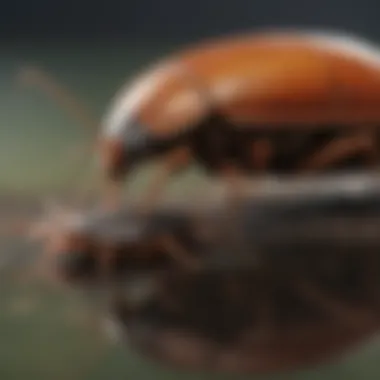
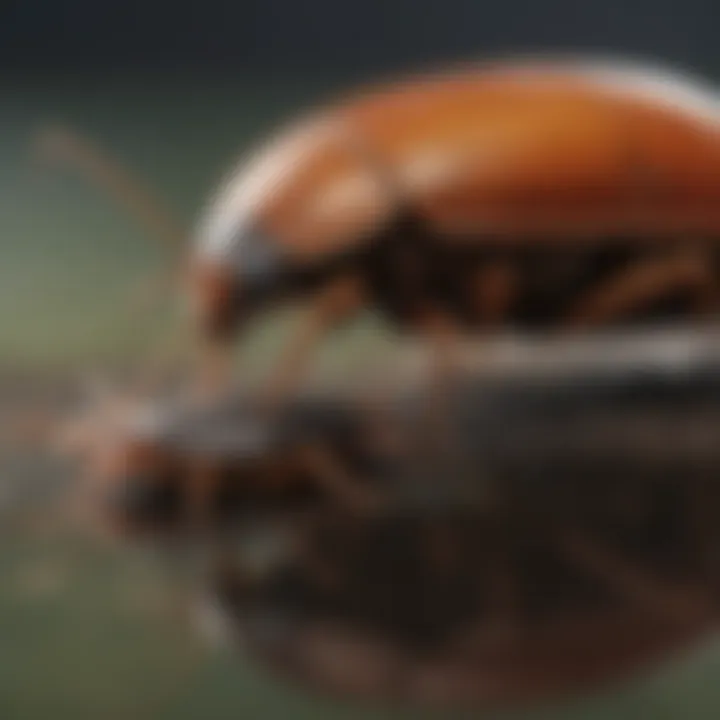
Their feeding habits can lead to significant damage, especially if left unchecked. For instance, roaches can contaminate food and kitchen surfaces with their droppings, posing health risks to humans.
Waterbug Dietary Preferences
Waterbugs, unlike roaches, have a more specific diet. They are primarily carnivorous. They feed on:
- Small aquatic creatures, such as tadpoles or minnows
- Insects that fall into water bodies
- Occasionally, decaying organic matter
Waterbugs are predatory insects. Their diet plays an essential role in local ecosystems, particularly in controlling aquatic insect populations. They capture prey using specialized mouthparts, allowing them to consume larger insects efficiently. In gardens or water features, their presence may indicate a balanced ecosystem, while their appetite for pests can be beneficial for plants and landscapes.
In summary, understanding the dietary preferences of both roaches and waterbugs reveals their adaptation strategies and ecological roles. This knowledge not only aids in pest management but also informs homeowners about maintaining a healthy home environment.
Reproductive Patterns
Reproductive patterns play a crucial role in understanding the lifecycle of both roaches and waterbugs. These patterns highlight how different species adapt to their environments and ensure their survival. Analyzing these techniques provides insights into their population dynamics, which are essential for managing and controlling these insects, particularly in household situations. For homeowners and enthusiasts, knowing how these creatures reproduce can inform effective pest control strategies and prevent infestations.
Roach Reproduction Techniques
Roaches exhibit unique reproductive strategies which contribute to their resilience. Female roaches carry egg cases, known as oothecae, that can contain up to 50 eggs. Once the eggs are ready to hatch, the female will securely deposit the ootheca in a protected location, often in dark, warm areas, ideal for development.
A few key points about roach reproduction include:
- High Fertility: Roaches can reproduce rapidly, with some species able to produce several oothecae in their lifetime.
- Parental Care: In some species, females can keep the ootheca attached to their bodies until the eggs are close to hatching, providing protection against environmental threats.
- Survival Rate: The young roaches, known as nymphs, are capable of surviving on their own shortly after hatching, thanks to their ability to feed on organic matter in their surroundings.
Waterbug Reproduction Techniques
Waterbugs, conversely, have their own distinct reproductive methods. The female waterbug does not produce multiple egg cases but lays individual eggs on submerged surfaces. These eggs stick to the water's edge, ensuring that they stay wet and can hatch successfully.
Important aspects of waterbug reproduction include:
- Brooding Behavior: After laying eggs, the male often hovers over them for protection until they hatch, showing a degree of parental care that is less common in many insect species.
- Hatching Process: Once the eggs hatch, the nymphs do not undergo a distinct metamorphosis as seen in some other insects, which allows them to develop directly into adults while often staying aquatic during the process.
- Environmental Conditions: Waterbugs prefer stable aquatic environments for reproduction, highlighting the importance of clean water bodies for their lifecycle.
Understanding the reproduction of both roaches and waterbugs not only provides insights into their habits but also aids in the development of control measures for these pests in various environments.
Ecological Impact
The ecological impact of roaches and waterbugs is a significant aspect of their existence. Understanding the roles these insects play in ecosystems can provide insight into their importance beyond being mere pests. Their interactions within their environments contribute to various ecological processes. Homeowners, garden enthusiasts, and design aficionados should recognize how these insects fit into the broader ecosystem. An informed perspective on these relationships can enhance pest management strategies as well.
Role of Roaches in Ecosystems
Roaches contribute greatly to the decomposition processes within ecosystems. As detritivores, they feed on decaying organic matter. This activity helps break down materials, returning nutrients to the soil. By reducing waste, roaches play a role in nutrient cycling, which is critical for soil health.
Many species of roaches also serve as prey for various birds, reptiles, and other predators. This positioning in the food web illustrates their importance in maintaining ecological balance. If roach populations were to decline significantly, it would impact those species that rely on them for food, leading to unforeseen consequences in the ecosystem.
Moreover, roaches have a remarkable capacity for adapting to different environments. This adaptability allows them to thrive in various habitats, from urban areas to forests. Such versatility highlights their resilience and the potential implications for pest control in different settings.
Role of Waterbugs in Ecosystems
Waterbugs, particularly members of the family Belostomatidae, are also vital components of aquatic ecosystems. These insects are predators in their respective habitats, preying on a range of organisms, including small fish and amphibians. This predatory behavior can help regulate populations of these species, contributing to the balance within aquatic ecosystems.
An interesting aspect of waterbugs is their role in nutrient cycling within water bodies. By consuming organic material and other aquatic life, they facilitate the breakdown of matter, which is essential for keeping water systems healthy. As top predators in some aquatic environments, their presence indicates a balanced ecosystem.
Furthermore, the hunting and feeding practices of waterbugs demonstrate how essential they are in various habitats, such as ponds and wetlands. Their behavior can affect the abundance and diversity of other aquatic organisms. If waterbug populations fluctuate, it can lead to changes in those ecosystems, making them significant beyond their direct interactions with humans.
The roles of both roaches and waterbugs illustrate the intricate connections within ecosystems, showcasing how their presence can influence other organisms and overall environmental health.
Human Interaction
Human interaction with roaches and waterbugs is pivotal for several crucial reasons. Both insects play distinct roles in their respective environments, yet their presence often causes concern among homeowners. Understanding these pests, their behaviors, and effective management strategies can empower individuals to take informed actions, reduce anxiety, and maintain healthier living spaces.
Roaches as Pests
Roaches are commonly viewed as significant pests in many households. They thrive in environments rich in food and warmth, making homes ideal for their survival. These insects are known for their rapid reproductive rates, contributing to population explosions when conditions are favorable. The sight of a roach, particularly in kitchens and bathrooms, can trigger fear and disgust among residents.
In addition to their unsettling appearance, roaches pose health risks. They can carry pathogens and allergens that may lead to respiratory problems and other ailments, especially in sensitive individuals. Effective pest management, therefore, is necessary to alleviate these risks. Common approaches include:
- Regular cleaning to eliminate food sources.
- Sealing cracks and crevices in walls and foundations.
- Utilizing traps and bait specifically designed for roaches.
- Consulting pest control professionals for severe infestations.
Taking proactive measures can help prevent roach invasions, ensuring a healthier and more comfortable home environment.
Waterbugs and Their Perception
Waterbugs often evoke a different set of perceptions compared to roaches. Though they share some physical similarities, many people regard waterbugs with more intrigue than disgust. Waterbugs, such as the Giant Water Bug, are primarily aquatic insects and usually found in water bodies like ponds and streams.
Despite their somewhat intimidating size, waterbugs are beneficial to ecosystems. They act as both predators and prey within aquatic food webs. However, when they enter homes, perceptions may shift. They can be mistaken for their less desirable cousins, leading to confusion and fear.
Waterbugs serve important ecological roles, yet their appearance in homes often evokes unnecessary panic.
To manage encounters with waterbugs:
- Identifying them accurately can reduce unwarranted concern.
- Maintaining cleanliness around water sources is advisable to deter their presence.
- If waterbugs are found indoors, capturing and releasing them outside when possible is recommended.
Understanding the ecological significance of waterbugs can help shift perceptions from fear to appreciation. This knowledge can foster a more balanced attitude toward these insects, allowing for coexistence rather than conflict.
Control Measures


Control measures are essential when it comes to managing roaches and waterbugs. Understanding their behaviors, habitats, and life cycles leads to effective solutions. The presence of these pests can affect both health and comfort in one’s home. By implementing control measures, homeowners take active steps to mitigate problems rather than waiting for infestations to escalate.
Effective control measures protect food sources, minimize disease risks, and improve overall sanitation. It is crucial to formulate a plan actively with practical strategies tailored to the specific pest behavior and breeding patterns.
Methods for Managing Roaches
Roaches are notorious for their resilience and adaptability. Here are some key methods to manage them effectively:
- Sanitation Practices: Keeping kitchens and living areas clean is the first step. Food crumbs should be cleaned, and dishes should not be left in the sink overnight.
- Seal Entry Points: Roaches can squeeze through surprisingly small gaps. Inspect areas around windows, doors, and pipes. Use caulk to seal cracks and gaps.
- Baiting Strategies: Using gel baits can attract roaches and allow for targeted control. Place baits in areas where roaches are frequently seen, like behind appliances or under sinks.
- Insect Growth Regulators (IGRs): These products can disrupt the life cycle of roaches. Apply them where you notice activity to reduce breeding significantly.
- Professional Extermination: In cases of severe infestation, contacting pest control specialists may be the most effective course of action. They have access to potent treatments that are not available for consumer use.
Approaches to Dealing with Waterbugs
Waterbugs require different strategies because they are often found near water sources. Here are some approaches:
- Eliminate Standing Water: Waterbugs thrive in damp environments. Regularly check and eliminate standing water from your home, especially in gardens and basements.
- Modify Landscapes: Landscaping changes can divert water away from the foundation of the house. Create drainage paths to reduce the presence of stagnant water that attracts waterbugs.
- Use Natural Predators: Introducing predators like fish that eat waterbug larvae can naturally keep their populations down. It is a sustainable approach that increases biodiversity.
- Boric Acid Applications: Applying boric acid around water sources can deter waterbugs. It works by dehydrating these pests when they come into contact with the chemical.
- Professional Help: Just like with roaches, if the issue persists, seeking professional pest control can provide long-term solutions specific to waterbug populations.
By utilizing these control measures thoughtfully, homeowners can manage pests effectively and maintain a comfortable living environment.
Health Implications
Understanding the health implications associated with roaches and waterbugs is essential for homeowners and gardening aficionados alike. Both insects are not only prevalent in various environments but can also pose significant health risks. Awareness of these risks can lead to more informed decisions regarding pest management and home care strategies.
Health Risks Associated with Roaches
Roaches are often viewed as unsightly pests, but their impact extends beyond mere aesthetics. They are known carriers of allergens and pathogens that can affect human health. The presence of roaches in a home can exacerbate allergies and asthma due to their fecal matter, saliva, and shed skin. Research has shown that roach allergens can contribute to significant respiratory issues, particularly in children and individuals with pre-existing conditions.
In addition to allergies, roaches can also transmit diseases. They are known to spread bacteria like Salmonella and E. coli. This transmission can occur through contaminated food, water, or surfaces. For instance, if a roach crawls over kitchen counters or food items, they can leave behind harmful microorganisms.
Furthermore, studies have indicated that some kinds of roaches can carry parasitic worms. This further complicates their health implications, making their eradication a priority for many households.
Health Risks Associated with Waterbugs
Waterbugs, while less common in human environments compared to roaches, still pose noticeable health risks. They have a reputation for being aggressive and can inflict painful bites, especially when humans inadvertently disturb their habitat. The bites can lead to swelling, itching, and sometimes serious allergic reactions in sensitive individuals.
Moreover, similar to roaches, waterbugs can harbor pathogens. While they are less likely to invade homes in the same way roaches do, they can contaminate water sources and food supplies if populations are not controlled. Waterbugs thrive in damp areas, making them a potential vector for diseases related to water contamination.
"Awareness of health risks is vital for maintaining a pest-free environment. Ignoring these risks can lead to severe consequences for family health."
In summary, both roaches and waterbugs carry distinct health risks that necessitate attention and proactive management. Recognizing these threats is crucial for maintaining a safe living space and informing pest control strategies. Homeowners and garden enthusiasts should prioritize sanitization and consider consulting with pest management professionals to mitigate these risks effectively.
Cultural Significance
Understanding the cultural significance of roaches and waterbugs provides insight into how humans interact with these insects beyond just the realm of pest control. Such knowledge is crucial for recognizing how these creatures influence art, literature, and societal beliefs. This section discusses the unique roles that both roaches and waterbugs hold in various cultures, emphasizing their perceived value and the connections they maintain with the human experience.
Roaches in Various Cultures
Roaches often carry a stigma due to their association with unsanitary conditions. However, this is not the full narrative. In some cultures, roaches symbolize resilience and adaptability. For example, Japanese folklore occasionally references cockroaches as creatures that survive even the harshest environments, which can lead to discussions about the importance of perseverance.
In popular media, roaches frequently appear as symbols of pestilence or decay. Yet, some artistic representations celebrate their unexpected beauty. This ambivalence is a rich topic in discussions about ecology and human sentiment.
- In literature, they can represent forgotten places or neglected corners of urban life.
- In contrast, certain tribes in Africa people utilize roaches in traditional medicine, highlighting a less common yet significant view of their role in cultural practices.
Waterbugs in Folklore and Culture
Waterbugs, unlike roaches, often evoke different reactions in cultural narratives. Many cultures view waterbugs favorably, associating them with water and life. In Native American traditions, some tribes see waterbugs as symbols of healing and transformation, representing the cycle of life. Their ability to thrive in diverse aquatic environments is often admired.
In Asian cultures, particularly in China, waterbugs are featured in local cuisine, exemplifying their role in culinary traditions. They are sometimes considered delicacies or ingredients in health remedies, emphasizing their integration into daily life rather than being dismissed as mere pests. Such cultural practices influence perceptions and underscore the necessity of studying local customs.
"Understanding cultural perspectives on insects can reshape how we approach pest control and management, highlighting their ecological importance instead of viewing them solely as nuisances."
Summary of Key Differences
Understanding the distinction between roaches and waterbugs is crucial for effective pest management and ecological awareness. This section highlights the essential differences between these two types of insects, focusing on various aspects such as physical traits, habitat preferences, and behavioral patterns. Recognizing these key elements allows homeowners and gardening enthusiasts to implement informed decisions and strategies in managing their environments.
One significant difference lies in the taxonomy of these insects. Roaches, belonging to the order Blattodea, encompass various species that are typically found in residential areas. Waterbugs, on the other hand, belong to the order Hemiptera and are often water-dwelling insects, adapting to aquatic environments.
Moreover, the behavioral characteristics of these insects also differ. Roaches are generally nocturnal and prefer warm, dark places, while waterbugs are more active in water and often hunt during the daytime.
Understanding these differences offers multiple benefits:
- It helps in accurately identifying pests.
- It assists in selecting the appropriate pest control methods.
- It contributes to better management practices in home and garden environments.
By examining these distinctions, homeowners can safeguard their spaces while fostering a deeper appreciation for the roles these insects play in our ecosystems.
Comparison Table of Roaches and Waterbugs
| Characteristic | Roaches | Waterbugs | | Taxonomy | Order: Blattodea | Order: Hemiptera | | Common Species | German Cockroach, American Cockroach | Toe-Biter, Abedus indentatus | | Habitat | Urban, warm areas, kitchens | Freshwater environments, ponds, slow-moving water | | Physical Appearance | Flat bodies, long antennae, oval shape | Broad body, prominent eyes, elongated flat bodies | | Diet | Omnivorous, scavengers | Carnivorous, feed on other aquatic insects | | Behavior | Nocturnal, typically secretive | Predatory, can be aggressive towards smaller insects | | Health Implications | Potential allergens, link to asthma | Rarely a health threat but may cause irritation |
By having this comparison table, readers can quickly grasp the fundamental differences, assisting them in identifying and managing these insect types more effectively.
Culmination
The importance of understanding the differences between roaches and waterbugs cannot be overstated. In both residential and ecological contexts, recognizing these two pests helps in identifying effective management strategies. By discerning their unique characteristics, it becomes easier to implement the correct pest control methods. Also, this understanding plays a critical role in minimizing the risks to health and property that both types of insects can pose.
Final Thoughts on Pest Management
In discussing pest management approaches, it’s vital to consider several factors.
- Identification: Accurate identification of the pest is the first step in effective management. Knowing whether you’re dealing with roaches or waterbugs can alter the strategy for dealing with them.
- Control Methods: Different pests require different control techniques. For instance, roaches may respond well to baiting and traps, while waterbugs may require environmental modifications to prevent their return.
- Preventive Measures: Prevention is always preferable to control. Keeping homes clean, sealing entry points, and managing moisture are practical steps that can provide longer-term solutions.
In summary, effectively managing pest populations begins with informed decision-making based on a clear understanding of the distinctions between roaches and waterbugs. Homeowners who recognize these differences will be better equipped to create a safe and comfortable living environment. They will also contribute positively towards ecosystem health by being more responsible pest managers.















